
by Kaye Dee
Just over a week ago I wrote about the Apollo-7 test flight – America’s successful return to space after the tragedy of the Apollo-1 fire. Just days after Apollo-7’s safe splashdown the Soviet Union also launched its own return-to-flight mission, Soyuz-3. As the Traveller noted in his recent commentary, like Apollo-7, Soyuz-3 represents the recommencement of the Russian manned spaceflight programme following its equally tragic loss of Soyuz-1 last year.
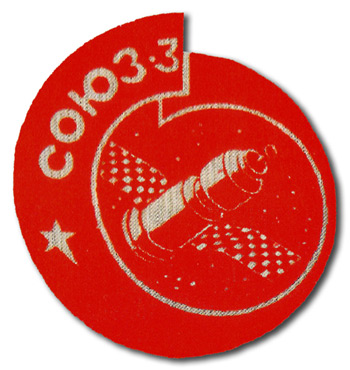 This is reported to be the official Soyuz-3 mission patch. It was apparently intended to be worn by Cosmonaut Beregovoi or at least flown during the mission, however it ia not clear if it was actually used
This is reported to be the official Soyuz-3 mission patch. It was apparently intended to be worn by Cosmonaut Beregovoi or at least flown during the mission, however it ia not clear if it was actually usedAs readers know, the Soviet space programme is secretive about its activities. Soyuz-3, which was launched on 26 October, has been particularly mysterious for a crewed spaceflight. The mission was preceded by the launch of the un-manned Soyuz-2, although that launch was not announced until after Soyuz-3 was in orbit. What can we make of the little we know so far about this flight, which had a duration of just a little under four days?
 New Cosmonaut, New Spacecraft
New Cosmonaut, New SpacecraftWe know from information released or gleaned at the time of Soyuz-1 that this new Soviet spacecraft is large, capable of carrying at least three cosmonauts – although on this mission, just as with Soyuz-1, there appears to have been only one man aboard, Colonel Georgi Beregovoi.
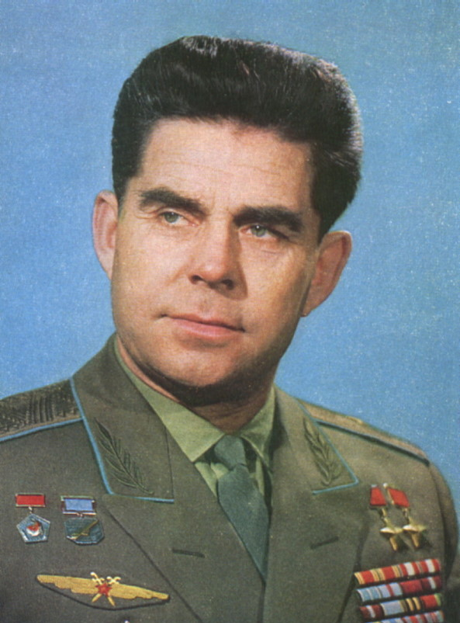 Although not previously known to be a member of the Soviet cosmonaut team, Col. Beregovoi is a distinguished World War Two veteran, who was awarded the decoration of Hero of the Soviet Union in 1944. After the war he became a test pilot and is said to have joined the cosmonaut team in 1964. At 47, Beregovoi now becomes the oldest person to make a spaceflight, taking the record away from 45-year-old Apollo-7 commander Capt. Wally Schirra only weeks after he achieved it.
Although not previously known to be a member of the Soviet cosmonaut team, Col. Beregovoi is a distinguished World War Two veteran, who was awarded the decoration of Hero of the Soviet Union in 1944. After the war he became a test pilot and is said to have joined the cosmonaut team in 1964. At 47, Beregovoi now becomes the oldest person to make a spaceflight, taking the record away from 45-year-old Apollo-7 commander Capt. Wally Schirra only weeks after he achieved it.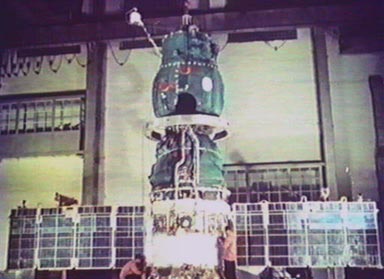 The few images of the Soyuz spacecraft available indicate that, unlike the Apollo Command Service Module, it has three sections: a ‘service module’ containing life-support and propulsion systems; and two other modules – one roughly bell-shaped and the other, attached to it, spherical – which both seem to be crew accommodation, given that press releases from the TASS newsagency have described the spacecraft as “two-roomed”.
The few images of the Soyuz spacecraft available indicate that, unlike the Apollo Command Service Module, it has three sections: a ‘service module’ containing life-support and propulsion systems; and two other modules – one roughly bell-shaped and the other, attached to it, spherical – which both seem to be crew accommodation, given that press releases from the TASS newsagency have described the spacecraft as “two-roomed”. The bell-shaped section seems to be the part of the spacecraft in which the crew return to Earth, protected by a heatshield. Interestingly, the service module supports a solar panel on either side, which must be folded within the launch shroud and extended once in orbit. The use of solar panels suggests that the USSR does not have the same fuel cell technology as NASA. However, it is also possible that the Soyuz is intended for missions in Earth orbit with an appreciably longer duration than a short trip to the Moon and back, as solar panels would be more efficient than fuel cells for that purpose.
NASA experts assume that, like Apollo-7, Soyuz-3 has been modified and/or re-designed over the past 18 months to address whatever issues have been identified as the cause of the loss of Soyuz-1. It is generally believed that Kosmos-238, which made a four-day flight in August, was an uncrewed Soyuz test flight in advance of the first mission with a crew on board.
How Many on Board?
Speculation and rumours abound as to how many cosmonauts were actually on board Soyuz-3. Official Soviet sources give the name of only one cosmonaut, the aforementioned Col. Beregovoi. However, a report in the armed forces newspaper, Red Star, has caused speculation that more than one cosmonaut may have been intended to be involved in the mission. In referring to the “crew” of Soyuz-3 the article used the plural when it spoke of cosmonauts who were planning to fly with Beregovoi.
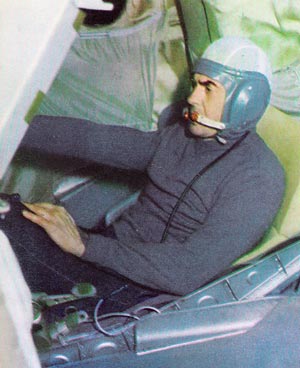 Colonel Beregovoi during his training at Star City
Colonel Beregovoi during his training at Star CityReporting about a meeting at the cosmonaut training centre “Star City” near Moscow, to mark the end of Soyuz-3’s training period, the Red Star article described a speech to the meeting by Colonel Beregovoi then said, “Others followed him. They spoke about the great work they had done and thanked their comrades. These in their turn wished them a happy flight, a good launching and a soft landing”. While this report could be taken to imply that more than one other person was expected to accompany Beregovoi on his flight, it may be that the “others” referred to were the mission’s back-up cosmonauts, since Soviet spaceflights apparently have two back-up crews.
 Cosmonaut Beregovoi on the launchpad, apparently alone
Cosmonaut Beregovoi on the launchpad, apparently aloneAn additional vague hint that there might be more than one cosmonaut aboard came Soyuz-3 came from a TASS news agency release referring to Beregovoi as the “commander” of the ship, a term that would seem unnecessary if he was the sole occupant of the spacecraft. Rumours with a more conspiracy-minded flavour have also suggested that one of Col. Beregovoi’s live broadcasts from space was filmed in such a manner that, while an empty seat could be seen on the cosmonaut’s left side, whatever was to his right was not visible, potentially concealing the presence of another crewmember. However, the angle may simply have been the result of a fixed camera, located to give whatever the Soviet mission controllers considered to be the best view of the spacecraft interior.
More than a Rendezvous?
The pre-occupation of Western observers with the possibility that there were other, unidentified cosmonauts on board Soyuz-3 stems from the comparatively basic activities reported as being carried out during the mission. True, the flight is assumed to have been a shakedown test along the same lines as Apollo-7, but the American craft nevertheless flew with a complete crew of three, including a designated Lunar Module pilot, even though a LM was not available for the mission. Yet the large Soyuz has officially flown with only a single crewmember. Does this mean that the Russians were still uncertain about the flightworthiness of the spacecraft and did not want to risk more than one life on the test flight? Or was a more ambitious mission planned that did not eventuate?
Apollo-7 carried out a range of complex manoeuvres and experiments during its test flight, while the only significant activities reported about Soyuz-3 were that it made two rendezvous with the automated Soyuz-2. Yet, an ambitious programme of spacecraft dockings and crew transfers had supposedly been planned for Soyuz-1 had that mission not struck trouble, and since October last year the USSR has apparently perfected the techniques of automated rendezvous and docking through the flights of Kosmos-186-188 and Kosmos-212-213.
 Was an actual docking between Soyuz-2 and 3 planned, in addition to the rendezvous manoeuvres, with one or two additional crew members from Soyuz-3 transferring to the automated craft to return from orbit? Did the Soviets keep the presence of additional cosmonauts on Soyuz-3 secret to save face in the event that such a docking and crew transfer failed? Even if Beregovoi was alone in Soyuz-3, was it planned for him to dock with Soyuz-2 to demonstrate that a pilot could accomplish a manual docking, similar to the capabilities demonstrated by the crew of Apollo-7? TASS press releases about the mission were ambiguously worded and extremely light on detail, so – as usual with the Soviet space programme – it may be a very long time before we have answers to these questions.
Was an actual docking between Soyuz-2 and 3 planned, in addition to the rendezvous manoeuvres, with one or two additional crew members from Soyuz-3 transferring to the automated craft to return from orbit? Did the Soviets keep the presence of additional cosmonauts on Soyuz-3 secret to save face in the event that such a docking and crew transfer failed? Even if Beregovoi was alone in Soyuz-3, was it planned for him to dock with Soyuz-2 to demonstrate that a pilot could accomplish a manual docking, similar to the capabilities demonstrated by the crew of Apollo-7? TASS press releases about the mission were ambiguously worded and extremely light on detail, so – as usual with the Soviet space programme – it may be a very long time before we have answers to these questions.The Mission as Reported
Although not announced until after the launch of Soyuz-3 (though my friends at the WRE report that it was detected by Western space tracking networks), the automated rendezvous target Soyuz-2 was launched on Friday 25 October, the day before the manned mission. Precision launch timing then placed Soyuz-3 into an orbit within seven and a half miles of its rendezvous target.
According to TASS, during its first orbit, Soyuz-3 “approached’’ to within 656 ft of Soyuz-2 using “an automatic system”, following which Cosmonaut Beregovoi manually effected a closer rendezvous. A second rendezvous was carried out on 27 October. This has puzzled Western space experts, who have said that they could see no immediate reason for such comparatively simple manoeuvres, which do not appear to represent any appreciable advance in Soviet space capabilities.
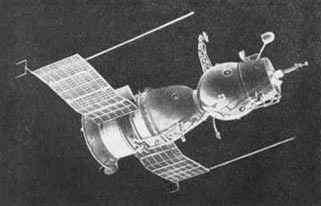 Soyuz-2 was remotely commanded to return to Earth after just three days. In what was presumably another demonstration of the Soyuz spacecraft’s redesigned landing system, TASS reported that the spacecraft’s re-entry was slowed by parachutes and cushioned “with the use of a soft-landing system at the last stage”.
Soyuz-2 was remotely commanded to return to Earth after just three days. In what was presumably another demonstration of the Soyuz spacecraft’s redesigned landing system, TASS reported that the spacecraft’s re-entry was slowed by parachutes and cushioned “with the use of a soft-landing system at the last stage”.It is unclear what activities Col. Beregovoi undertook during his final two days in orbit. Official TASS bulletins said only that the cosmonaut was “going ahead with his flight programme”, which apparently included conducting “scientific, technical, medical, and biological experiments and research”. The “research” may possibly have included observations of the Earth for meteorological and intelligence gathering purposes. The cosmonaut also made live television broadcasts from Soyuz-3, during one of which he provided a brief “tour” of the spacecraft interior. In a short, three-minute broadcast, Beregovoi was also shown thumbing through his log-book and adjusting his radio communications cap.
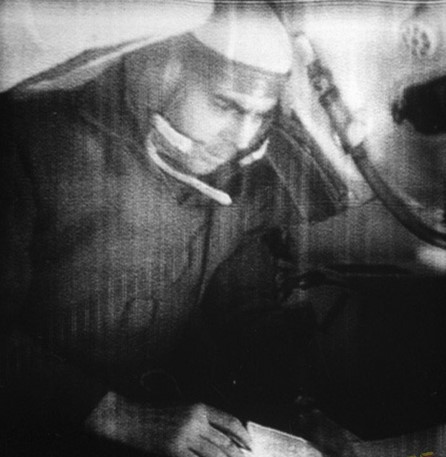 A still from the three-minute brodcast from Soyuz-3 showing Colonel Beregovoi
A still from the three-minute brodcast from Soyuz-3 showing Colonel BeregovoiThe flight was repeatedly said to be “proceeding normally”, with the Colonel “feeling fine” and the spaceship “functioning normally”. We did learn that Soyuz-3 moved to a new orbit after Soyuz-2’s de-orbit, and that the cosmonaut’s daily routine included 25 minutes of morning exercise before breakfast, but whatever else the mission may have actually accomplished remains a mystery.
Back to Earth
After almost exactly four days in space, Soyuz-3 returned to Earth, landing safely on the snowy steppes of Kazakhstan near the city of Karaganda. TASS reported that “After his landing, Georgi Beregovoi feels well. Friends and correspondents met him in the area of the landing”. The cosmonaut has since been reported as saying that his landing was so easy he hardly felt the impact at all.

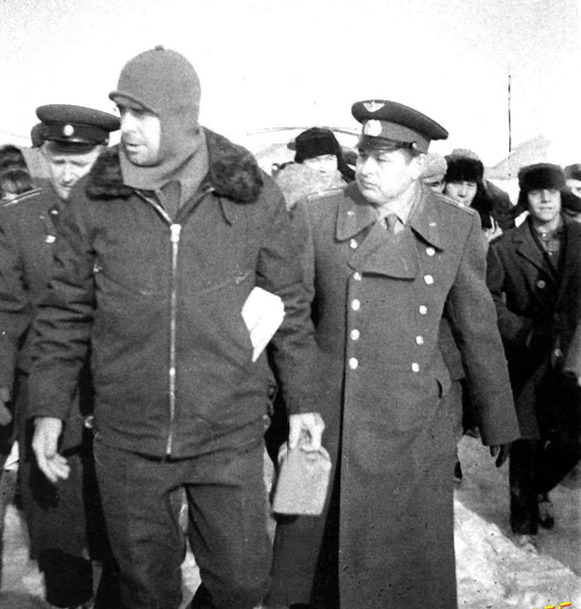 Following his safe return, Col. Beregovoi was flown to Moscow, where he received a red-carpet welcome, an instant promotion to Major-General and the award of the Order of Lenin. At the ceremony, the Soviet party leader, Mr Brezhnev, devoted most of his 15-minute speech to praise of the Soviet manned space programme, describing Soyuz-3 as a “complete success”. He said that the mission had brought nearer the day when “Man will not be the guest but the host of space”. He also offered a word of praise to the Apollo-7 astronauts, referring to them as “courageous”.
Following his safe return, Col. Beregovoi was flown to Moscow, where he received a red-carpet welcome, an instant promotion to Major-General and the award of the Order of Lenin. At the ceremony, the Soviet party leader, Mr Brezhnev, devoted most of his 15-minute speech to praise of the Soviet manned space programme, describing Soyuz-3 as a “complete success”. He said that the mission had brought nearer the day when “Man will not be the guest but the host of space”. He also offered a word of praise to the Apollo-7 astronauts, referring to them as “courageous”. A Step on the Way to the Moon?
So, what was the purpose of the Soyuz-3 mission? Dr. Welsh’s recently-mentioned comment that Soyuz and Zond spacecraft are different vehicles and that the Russians are not yet ready to attempt a lunar mission, seems to be borne out by statements from Soviet academician and aerospace scientist, Prof. Leonid Sedov, during a visit to the University of Tennessee Space Institute on 31 October-1 November. Prof. Sedov has said that the USSR would reach Moon from a space station in Earth orbit but would not conduct manned lunar space operations within the next six months. He indicated that Zond-type satellites would circumnavigate other planets and return and told the university audience that Soyuz-3 was part of a “programme to develop operations around the Earth”.
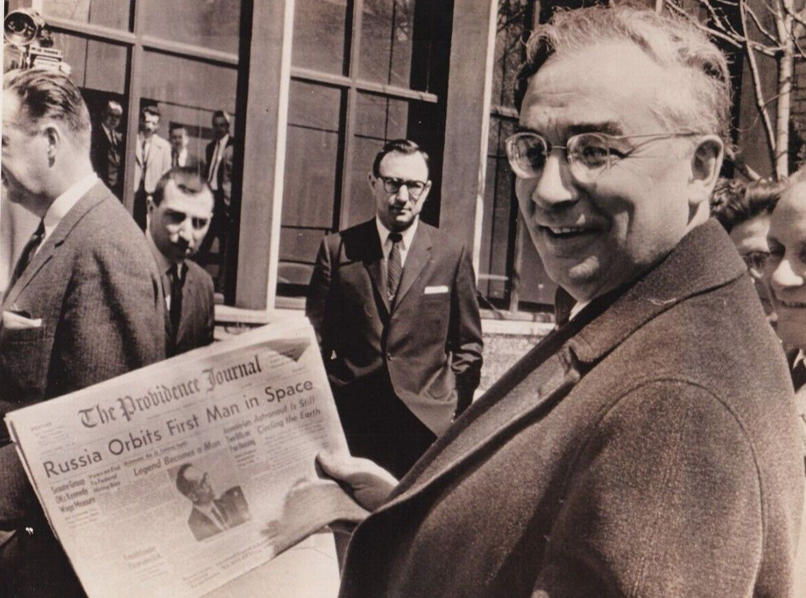 Prof. Sedov on an earlier visit to the United States in 1961 at the time of the USSR's first manned spaceflight
Prof. Sedov on an earlier visit to the United States in 1961 at the time of the USSR's first manned spaceflightMastering the techniques of rendezvous and docking would certainly be necessary to establish the orbiting space station from which a Soviet Moon mission would be launched, but Sedov’s comments leave unanswered the question of why a docking between Soyuz-2 and 3 was not attempted during the mission – unless an attempted docking did fail.
Awards All Round
Despite their testiness during the flight, the overall success of the Apollo-7 mission has been recognised by the presentation of NASA’s second highest award, the Exceptional Service Medal, to the crew at a ceremony in Texas on 2 November, presided over by President Johnson. During the ceremony, the President said the United States was “ready to take that first great step out into the Solar System and on to the surface of the nearest of the many mysterious worlds that surround us in space.” He noted that Apollo-7 had logged more than 780 man-hours in space, which is more than has been logged “in all Soviet manned flights to date”.
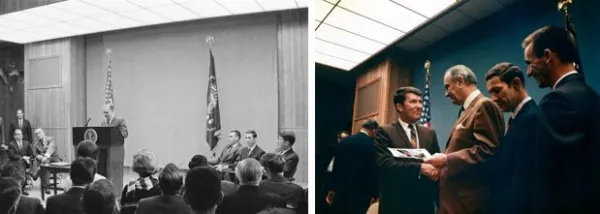 Left: Former NASA Administrator James Webb speaking at the Apollo-7 awards event, at which he also received NASA's highest award. Right: After the formal ceremony, President Johnson
(second from left) chats with Apollo 7 astronauts Schirra, Eisele and Cunningham.
Left: Former NASA Administrator James Webb speaking at the Apollo-7 awards event, at which he also received NASA's highest award. Right: After the formal ceremony, President Johnson
(second from left) chats with Apollo 7 astronauts Schirra, Eisele and Cunningham.At the same ceremony, President Johnson presented the NASA Distinguished Service Medal, the space agency’s highest award, to recently-retired NASA Administrator James E. Webb, for his outstanding leadership of NASA from 1961-1968.
NASA has also recently indicated that it will make a decision on the plans for the Apollo-8 mission on 11 November. The space agency has listed the alternatives for the December mission as: an Earth orbital mission deeper into space; a circumlunar fly-by; or a lunar orbit mission. These are all exciting prospects, but I'm hoping that NASA will choose the boldest option and go for a lunar orbit mission. To have human eyes see the Earth from the Moon for the very first time would be a Christmas present indeed!


